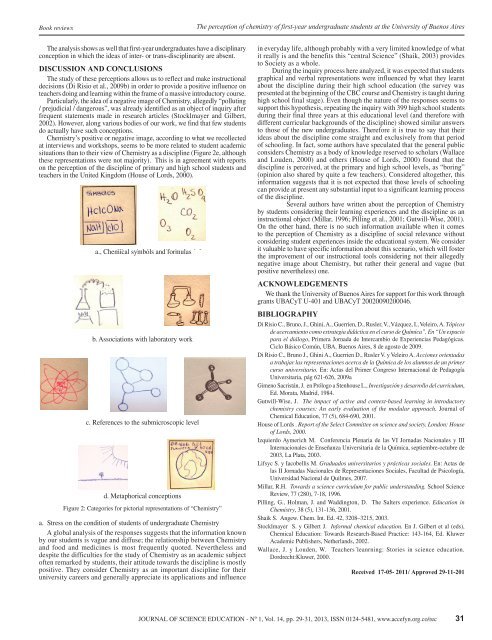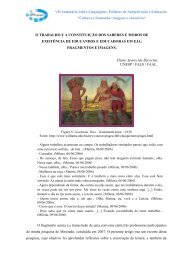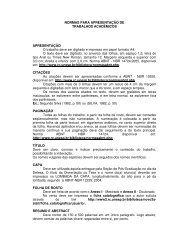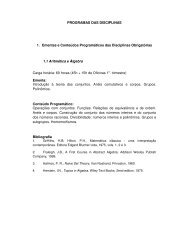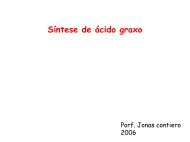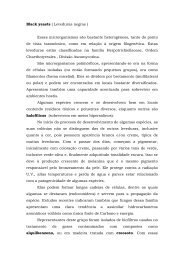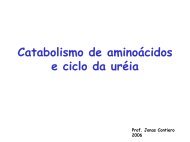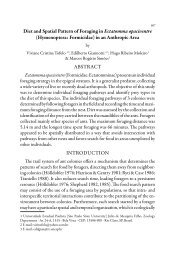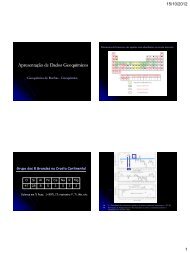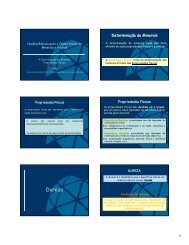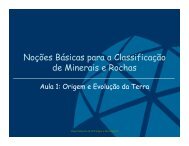Vol. 14 N° 1, 2013 - UNESP Rio Claro
Vol. 14 N° 1, 2013 - UNESP Rio Claro
Vol. 14 N° 1, 2013 - UNESP Rio Claro
You also want an ePaper? Increase the reach of your titles
YUMPU automatically turns print PDFs into web optimized ePapers that Google loves.
Book reviews<br />
The perception of chemistry of first-year undergraduate students at the University of Buenos Aires<br />
The analysis shows as well that first-year undergraduates have a disciplinary<br />
conception in which the ideas of inter- or trans-disciplinarity are absent.<br />
DISCUSSION AND CONCLUSIONS<br />
The study of these perceptions allows us to reflect and make instructional<br />
decisions (Di Risio et al., 2009b) in order to provide a positive influence on<br />
teachers doing and learning within the frame of a massive introductory course.<br />
Particularly, the idea of a negative image of Chemistry, allegedly “polluting<br />
/ prejudicial / dangerous”, was already identified as an object of inquiry after<br />
frequent statements made in research articles (Stocklmayer and Gilbert,<br />
2002). However, along various bodies of our work, we find that few students<br />
do actually have such conceptions.<br />
Chemistry’s positive or negative image, according to what we recollected<br />
at interviews and workshops, seems to be more related to student academic<br />
situations than to their view of Chemistry as a discipline (Figure 2e, although<br />
these representations were not majority). This is in agreement with reports<br />
on the perception of the discipline of primary and high school students and<br />
teachers in the United Kingdom (House of Lords, 2000).<br />
f mary primary and and high high school school students students and and teachers teachers in the in United the United Kingdom Kingdom (House (House of of<br />
mary and and high high school students and and teachers in in the the United Kingdom (House of of<br />
, ords, 2000). 2000).<br />
, 2000).<br />
a) a., Chemical a) Chemical symbols symbols and and formulas formulas and formulas<br />
a) a) Chemical symbols and and formulas<br />
b) Associations b) Associations with with laboratory laboratory work work<br />
b) b) Associations with with laboratory work<br />
b. Associations with laboratory work<br />
c) References<br />
c.<br />
c) References to the the to submicroscopic the submicroscopic level<br />
level<br />
level<br />
c) c) References to to the the submicroscopic level<br />
d) d. Metaphorical d) Metaphorical conceptions conceptions conceptions<br />
d) d) Metaphorical conceptions<br />
Figure 2: Categories for pictorial representations of “Chemistry”<br />
a. Stress on the condition of students of undergraduate Chemistry<br />
A global analysis of the responses suggests that the information known<br />
by our students is vague and diffuse; the relationship between Chemistry<br />
and food and medicines is most frequently quoted. Nevertheless and<br />
despite the difficulties for the study of Chemistry as an academic subject<br />
often remarked by students, their attitude towards the discipline is mostly<br />
positive. They consider Chemistry as an important discipline for their<br />
university careers and generally appreciate its applications and influence<br />
igure 2: Categories 2: Categories for pictorial for pictorial representations representations of “Chemistry” of “Chemistry”<br />
2: 2: Categories for for pictorial representations of of “Chemistry”<br />
e) Stress e) Stress on the on condition the condition of students of students of undergraduate of undergraduate Chemistry Chemistry<br />
e) e) Stress on on the the condition of of students of of undergraduate Chemistry<br />
in everyday life, although probably with a very limited knowledge of what<br />
it really is and the benefits this “central Science” (Shaik, 2003) provides<br />
to Society as a whole.<br />
During the inquiry process here analyzed, it was expected that students<br />
graphical and verbal representations were influenced by what they learnt<br />
about the discipline during their high school education (the survey was<br />
presented at the beginning of the CBC course and Chemistry is taught during<br />
high school final stage). Even though the nature of the responses seems to<br />
support this hypothesis, repeating the inquiry with 399 high school students<br />
during their final three years at this educational level (and therefore with<br />
different curricular backgrounds of the discipline) showed similar answers<br />
to those of the new undergraduates. Therefore it is true to say that their<br />
ideas about the discipline come straight and exclusively from that period<br />
of schooling. In fact, some authors have speculated that the general public<br />
considers Chemistry as a body of knowledge reserved to scholars (Wallace<br />
and Louden, 2000) and others (House of Lords, 2000) found that the<br />
discipline is perceived, at the primary and high school levels, as “boring”<br />
(opinion also shared by quite a few teachers). Considered altogether, this<br />
information suggests that it is not expected that those levels of schooling<br />
can provide at present any substantial input to a significant learning process<br />
of the discipline.<br />
Several authors have written about the perception of Chemistry<br />
by students considering their learning experiences and the discipline as an<br />
instructional object (Millar, 1996; Pilling et al., 2001; Gutwill-Wise, 2001).<br />
On the other hand, there is no such information available when it comes<br />
to the perception of Chemistry as a discipline of social relevance without<br />
considering student experiences inside the educational system. We consider<br />
it valuable to have specific information about this scenario, which will foster<br />
the improvement of our instructional tools considering not their allegedly<br />
negative image about Chemistry, but rather their general and vague (but<br />
positive nevertheless) one.<br />
ACKNOWLEDGEMENTS<br />
We thank the University of Buenos Aires for support for this work through<br />
grants UBACyT U-401 and UBACyT 20020090200046.<br />
BIBLIOGRAPHY<br />
Di Risio C., Bruno, J., Ghini, A., Guerrien, D., Rusler, V., Vázquez, I., Veleiro, A. Tópicos<br />
de acercamiento como estrategia didáctica en el curso de Química. En Un espacio<br />
para el diálogo, Primera Jornada de Intercambio de Experiencias Pedagógicas.<br />
Ciclo Básico Común, UBA. Buenos Aires, 8 de agosto de 2009.<br />
Di Risio C., Bruno J., Ghini A., Guerrien D., Rusler V. y Veleiro A. Acciones orientadas<br />
a trabajar las representaciones acerca de la Química de los alumnos de un primer<br />
curso universitario. En: Actas del Primer Congreso Internacional de Pedagogía<br />
Universitaria, pág 621-626, 2009a<br />
Gimeno Sacristán, J. en Prólogo a Stenhouse L., Investigación y desarrollo del currículum,<br />
Ed. Morata, Madrid, 1984.<br />
Gutwill-Wise, J. The impact of active and context-based learning in introductory<br />
chemistry courses: An early evaluation of the modular approach. Journal of<br />
Chemical Education, 77 (5), 684-690, 2001.<br />
House of Lords . Report of the Select Committee on science and society. London: House<br />
of Lords, 2000.<br />
Izquierdo Aymerich M. Conferencia Plenaria de las VI Jornadas Nacionales y III<br />
Internacionales de Enseñanza Universitaria de la Química, septiembre-octubre de<br />
2003, La Plata, 2003.<br />
Lifsyc S. y Iacobellis M. Graduados universitarios y prácticas sociales. En: Actas de<br />
las II Jornadas Nacionales de Representaciones Sociales, Facultad de Psicología,<br />
Universidad Nacional de Quilmes, 2007.<br />
Millar, R.H. Towards a science curriculum for public understanding. School Science<br />
Review, 77 (280), 7-18, 1996.<br />
Pilling, G., Holman, J. and Waddington, D. The Salters experience. Education in<br />
Chemistry, 38 (5), 131-136, 2001.<br />
Shaik S. Angew. Chem. Int. Ed. 42, 3208–3215, 2003.<br />
Stocklmayer S. y Gilbert J. Informal chemical education. En J. Gilbert et al (eds),<br />
Chemical Education: Towards Research-Based Practice: <strong>14</strong>3-164, Ed. Kluwer<br />
Academic Publishers, Netherlands, 2002.<br />
Wallace, J. y Louden, W. Teachers´leanrning: Stories in science education.<br />
Dordrecht:Kluwer, 2000.<br />
Received 17-05- 2011/ Approved 29-11-201<br />
JOURNAL OF SCIENCE EDUCATION - Nº 1, <strong>Vol</strong>. <strong>14</strong>, pp. 29-31, <strong>2013</strong>, ISSN 0124-5481, www.accefyn.org.co/rec<br />
31


